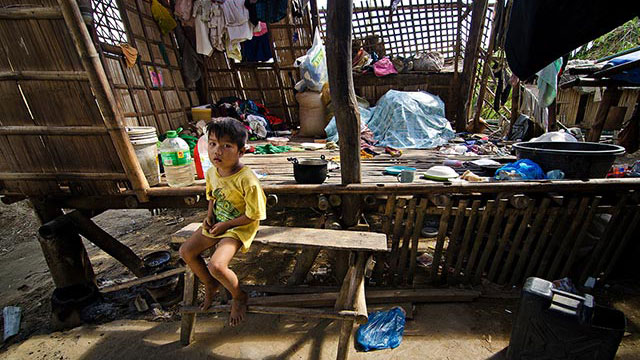SUMMARY
This is AI generated summarization, which may have errors. For context, always refer to the full article.

ILOILO, Philippines – Several fishermen lost their livelihood to the sea as the ropes that they were using to tie their boats on the docks broke at the height of Typhoon Yolanda (Haiyan) on November 8.
Residents of Barangay Piliwan Luca in Ajuy town are, however, trying to rebuild their homes with these ropes that were washed ashore.
“We don’t even have a peso to buy some nails that will hold this temporary shelter together,” said Merlyn Delcampo, a vegetable vendor in Piliwan Luca.
She is staying with her family in a small makeshift-shelter, bound only by the ropes they had gathered from the seashore.
During Yolanda’s onslaught, Merlyn’s home was battered by strong winds and chest-deep flood due to the overflowing of the nearby Tawili Dam. Her grandchildren nearly got drowned, if not for the help of her neighbors.
But Glen Ticzon, executive assistant of the Ajuy mayor, said the government’s priority at the moment is “relief, not rehabilitation.”
However, with the aid gradually reaching the Western Visayas area, shelters from the National Housing Authority and the UN Habitat housing kits are expected to come to the municapality sooner or later.
By that time, when the memories of Yolanda’s destruction will no longer be as vivid as they are now, Merlyn hopes they will be able not only to rebuild from the scratches of a storm, but to build a real new home.
“It was as if our home was instantly swallowed by water. In just a matter of hours, the farm turned into a lake,” Merlyn said.
“Before the typhoon broke out, we were told to prepare. We even stayed in our neighbor’s concrete house for the sake of our safety, but we weren’t expecting the typhoon to be that immensely strong,” she added.
Merlyn and her family hid in her neighbor’s house, which she thought could keep them safe. However, Typhoon Yolanda proved to be more destructive as the walls of the house which were made from hollowblocks began crumbling upon them, even causing some injuries to her neighbor’s head.
They swam out of the house and headed to another neighbor’s home, which was not affected by the surge of the water.
By morning, when the water had subsided, Merlyn and her family found themselves with no home to go back to. What welcomed them instead were the sight of strewn woods, uprooted trees lying on the damp earth, and parts of their walls – what’s left of what used to be her 24-sq ft house.
“We thought that our dogs and chickens were all dead. Surprisingly, we found them safe in the branches of some fallen trees,” Merlyn said.
Although Merlyn claims that she’s grateful that she and her family survived the disaster, she said their living condition is a far cry from okay. Their temporary shelter might become their house for a long since they don’t have the money to build a new home. – Rappler.com
(The writer is a volunteer for the Typhoon Yolanda Story Hub Visayas, a citizen journalism portal created on Nov 13, 2013, by veteran journalists, student writers, mobile journalists, and photographers based in Iloilo City. The Hub delivers reports from across the Panay Island, especially the severely damaged and minimally covered northern Iloilo and the provinces of Antique, Capiz, and Aklan.)
Add a comment
How does this make you feel?
There are no comments yet. Add your comment to start the conversation.